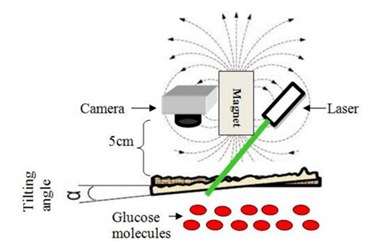New Biometric Wristwatches Use Light To Measure Vital Signs
By Joel Lindsey

In two separate projects, researchers are working to create biometric watches that use light to non-invasively and accurately measure important vital statistics — such as blood glucose levels, hydration levels, and pulse.
Papers describing both projects have been published recently in The Optical Society’s (OSA) online journal Biomedical Optics Express.
In the first paper, researchers at Israel’s Bar-Ilan University describe creating a biometric watch that uses a laser to illuminate a portion of skin near an artery in the wearer’s wrist while a camera monitors changes in the light that is backscattered off the skin.
The device monitors the “speckle effect” created on the wearer’s skin — or the grainy interference patterns that the laser lights produce on uneven or opaque surfaces. Because this feedback changes according to the flow of blood beneath the illuminated skin, this approach provides an effective way to measure certain properties of a wearer’s blood, according to a press release published recently by the OSA.
Along with the laser and the camera, the wristwatch device also has a magnet that enables the device to monitor glucose levels. Glucose molecules are capable of changing the polarization of the device’s magnetic field, so their presence alters the feedback recorded by the camera. Analyzing patterns in these changes provides a measurement of how much glucose is present in the blood at any given moment.
Additionally, scientists working on the project found that by gauging the overall strength of the signals picked up by the device, the wristwatch could also measure whether or not a wearer was dehydrated.
“Glucose is the holy grail of the world of biomedical diagnostics, and dehydration is a very useful parameter in the field of wellness, which is one of our main commercial aims,” Zeev Zalevsky, a bioengineer at Bar-Ilan University involved with the project, said in the press release. “The main factor for errors now is the stability of our device on the wrist of the user. We are currently investing efforts in deriving proper calibration and motion cancellation procedures that will allow us to reduce this sensitivity.”
The second paper describes efforts by researchers at the Delft University of Technology, in the Netherlands, and Phillips Research to create a wearable non-invasive pulse monitor that could operate without being disrupted by the wearer’s movements.
Taking advantage of the same speckle effect monitored by the glucometer wristwatch, researchers involved with this second project have created a device that can measure the feedback from an illuminated patch of skin in order to determine the pulse rate of the blood flowing beneath it. In particular, researchers found that even a rough image of the light reflecting back into a camera could be sufficient for generating accurate pulse rate measurements, making it possible to gather such data, even while in motion.
“This paper shows for the first time that a speckle pattern generated from a flowing liquid can give us the pulsation properties of the flow in spite of motion-induced artifacts,” said Mahsa Nemati, a graduate student at the Delft University of Technology who is involved with the project, in the OSA press release. “Sophisticated optics is not necessary to implement this, so the costs for devices can be kept low. Another advantage is that the devices can be non-contact or far from the sample.”
Image Credit: Biomedical Optics Express
